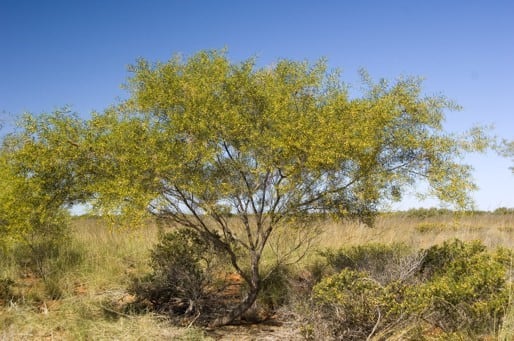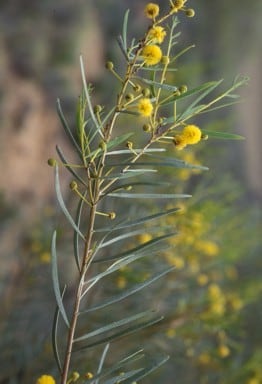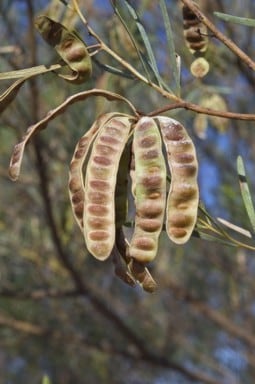Acacia sabulosa Maslin
WATTLE
Acacias of Australia
Family
Fabaceae
Distribution
Discontinuous, occurring near Roebourne, Port Hedland, Mandora (c. 250 km due NE of Port Hedland) and Marble Bar, and in the south-central Great Sandy Desert and the Little Sandy Desert, north-western W.A.; also occurs near Fiddlers Lake, N.T.
Description
Bushy, ±obconic, normally multistemmed shrub or sometimes tree 1–3 (–5) m high, glabrous, resinous. Phyllodes normally linear, usually 6–10 cm long and 1–3.5 mm wide with l:w = 20–100, narrowed at base, ±straight, thin, green, sometimes scurfy (especially on nerves), sparsely tuberculate; midrib not prominent, the minor nerves few, obscure (commonly not visible on narrowest phyllodes) and openly longitudinally anastomosing with some ±parallel to midrib; gland circular to oblong–elliptic, 0.2–0.5 mm long, 1–2 (–5) mm above pulvinus, with a smaller gland at base of mucro. Inflorescences simple, initiated synchronously with phyllodes on new shoots, 1 or 2 per axil; peduncles 6–20 mm long, slender, ebracteate at base; heads globular, densely 35–50-flowered, bright light golden. Flowers 5-merous; sepals 3/4–5/6-united. Pods narrowly oblong, flat, raised over seeds alternately on each side, to 6 cm long, 10–12 mm wide, chartaceous, transversely reticulate, yellow-brown to light brown. Seeds transverse to slightly oblique, oblong to elliptic, 4–4.5 mm long; funicle and aril membranous, creamy white.
Phenology
Flowers May–July.
Habitat
Grows in deep red or brown sand, commonly on dunes, associated with spinifex.
Specimens
W.A.: Lake Auld, A.S.George 15667 (CANB, K, MEL, NY, PERTH); 8 km E of Telfer Mining Centre, E.M.Goble-Garratt 245 (CANB, MO, PERTH); 26 km due ESE of Sandfire Roadhouse, between Port Hedland and Broome, B.R.Maslin 4878 (NSW, PERTH). N.T.: c. 16 km SSE of Fiddlers Lake, Sangsters Bore area, D.E.Albrecht 6176 (DNA, PERTH).
Notes
A few specimens have atypically short/broad, narrowly oblong phyllodes, 5–7 cm long, 5–6 mm wide,
l:w = 10–15 (e.g. Telfer Mining Centre, E.M.Goble-Garratt 93, BRI, PERTH). The typical form grows in the same region.
Near A. jensenii, which has generally shorter broader phyllodes and a more open growth habit with normally one or two main stems arising from the base. Along with A. jensenii and A. melleodora, A. sabulosa may possibly be better treated as an infraspecific taxon of A. dictyophleba. Acacia sabulosa vegetatively resembles A. hockingsii.
FOA Reference
Data derived from Flora of Australia Volumes 11A (2001), 11B (2001) and 12 (1998), products of ABRS, ©Commonwealth of Australia
Author
B.R.Maslin
This identification key and fact sheets are available as a mobile application:
URL: https://apps.lucidcentral.org/wattle/
© Copyright 2018. All rights reserved.















